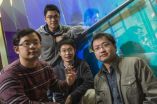(Press-News.org) The adverse side effects of certain hepatitis C medications can now be replicated and observed in Petri dishes and test tubes, thanks to a research team led by Craig Cameron, the Paul Berg Professor of Biochemistry and Molecular Biology at Penn State University. "The new method not only will help us to understand the recent failures of hepatitis C antiviral drugs in some patients in clinical trials," said Cameron. "It also could help to identify medications that eliminate all adverse effects." The team's findings, published in the current issue of the journal PLOS Pathogens may help pave the way toward the development of safer and more-effective treatments for hepatitis C, as well as other pathogens such as SARS and West Nile virus.
First author Jamie Arnold, a research associate in Cameron's lab at Penn State, explained that the hepatitis C virus (HCV), which affects over 170,000,000 people worldwide, is the leading cause of liver disease and, although antiviral treatments are effective in many patients, they cause serious side effects in others. "Many antiviral medications for treating HCV are chemical analogs for the building blocks of RNA that are used to assemble new copies of the virus's genome, enabling it to replicate," he said. "These medications are close enough to the virus's natural building blocks that they get incorporated into the virus's genome. But they also are different in ways that lead to the virus's incomplete replication. The problem, however, is that the medication not only mimics the virus's genetic material, but also the genetic material of the patient. So, while the drug causes damage to the virus, it also may affect the patient's own healthy tissues."
A method to reveal these adverse side effects in the safety of a laboratory setting, rather than in clinical trials where patients may be placed at risk, has been developed by the research team, which includes Cameron; Arnold; Suresh Sharma, a research associate in Cameron's lab; other scientists at Penn State; and researchers from other academic, government, and corporate labs. "We have taken anti-HCV medications and, in Petri dishes and test tubes, we have shown that these drugs affect functions within a cell's mitochondria," Cameron explained. "The cellular mitochondria --- a tiny structure known as 'the powerhouse of the cell' that is responsible for making energy known as ATP -- is affected by these compounds and is likely a major reason why we see adverse effects." Cameron noted that scientists have known for some time that certain individuals have "sick" mitochondria. Such individuals are likely more sensitive to the mitochondrial side effects of antiviral drugs.
"We know that antiviral drugs, including the ones used to treat HCV, affect even normal, healthy mitochondria by slowing ATP output," Arnold added. "While a person with normal mitochondria will experience some ATP and mitochondrial effects, a person who is already predisposed to mitochondrial dysfunction will be pushed over the 'not enough cellular energy' threshold by the antiviral drug. The person's mitochondria simply won't be able to keep up."
One of the problems with clinical trials, Arnold explained, is that a drug may be shown to be quite effective but, if even a miniscule percentage of patients have side effects, the U.S. Food and Drug Administration is obligated to put the trial on hold or stop the trial altogether. This possibility makes drug companies reluctant to invest money in drug trials after an adverse event has been observed, even when the drugs could still help millions of people. The researchers hope that their methods eventually will become a part of the pre-clinical development process for this class of antiviral drugs. "If we can show, in the lab, that a drug will cause side effects, then these compounds will not enter lengthy, expensive clinical trials and cause harm to patients " he said. "What's more, a drug company can invest its money more wisely and carefully in drug research that will produce safe and effective products. Better and more-willing investments by drug companies ultimately will help patients, because resources will be spent developing drugs that not only work, but that are safe for all patients."
Cameron added that the next step for his team is to identify the genes that make some individuals respond poorly to these particular antiviral treatments. "By taking blood samples from various patients and using the new method to test for toxicity in the different samples, we hope to discover which individuals will respond well and which will experience mitochondrial reactions, based on their genetic profiles," he said. "That is, we hope to use this method as a step toward truly personalized medicine, opening the door to pre-screening of patients so that those with mitochondrial diseases can be treated with different regimens from the start."
The team members also hope their method will be a means to study toxicity and side effects in other diseases. "Specifically, our technology will illuminate toxicity of a particular class of compounds that interrupts viral RNA synthesis," Cameron said. "While this class of compounds currently is being developed for treatment of HCV, a wide range of other RNA viruses, including West Nile virus, Dengue virus, SARS coronavirus, and perhaps even the Ebola virus, could be treated using this class of compounds as well."
INFORMATION:
In addition to Cameron, Arnold, and Sharma, other researchers who contributed to this study include Eric D. Smidansky from Penn State; Joy Y. Feng, Adrian S. Ray, Aesop Cho, Jason Perry, Jennifer E. Vela, Yeojin Park, Yili Xu, Yang Tian, Darius Babusis, Ona Barauskus, and Weidong Zhong from Gilead Sciences, Inc.; Maria L. Kireeva and Mikhail Kashlev from the Frederick National Laboratory for Cancer Research; Blake R. Peterson from the University of Kansas; and Averell Gnatt from the University of Maryland School of Medicine.
The research was funded by the National Institutes of Health and a Penn State Paul Berg Endowment.
CONTACTS
Craig E. Cameron: 814-863-8705, cec9@psu.edu
Barbara Kennedy (PIO): 814-863-4682, science@psu.edu
IMAGE
A high-resolution image associated with this research is online at http://www.science.psu.edu/news-and-events/2012-news/Cameron11-2012.
GRANT NUMBERS
NIH AI045818 (NIAID)
Hepatitis C treatment's side effects can now be studied in the lab
2012-11-17
ELSE PRESS RELEASES FROM THIS DATE:
Antenna-on-a-chip rips the light fantastic
2012-11-17
HOUSTON – (Nov. 16, 2012) – A device that looks like a tiny washboard may clean the clocks of current commercial products used to manipulate infrared light.
New research by the Rice University lab of Qianfan Xu has produced a micron-scale spatial light modulator (SLM) like those used in sensing and imaging devices, but with the potential to run orders of magnitude faster. Unlike other devices in two-dimensional semiconducting chips, the Rice chips work in three-dimensional "free space."
Xu and his Rice colleagues detailed their antenna-on-a-chip for light modulation ...
Basketball teams offer insights into building strategic networks
2012-11-17
TEMPE, Ariz. – What started out as a project to teach undergraduate students about network analysis, turned into an in-depth study of whether it was possible to analyze a National Basketball Association (NBA) basketball team's strategic interactions as a network. Arizona State University researchers discovered it is possible to quantify both a team's cohesion and communication structure.
The researchers' findings appear in an online November issue of PLOS ONE.
Jennifer Fewell, a professor in ASU's School of Life Sciences in the College of Liberal Arts and Sciences, ...
Level up: Study reveals keys to gamer loyalty
2012-11-17
BUFFALO, N.Y. -- Online role-playing game developers can get ahead of the competition by giving gamers more opportunities to get social, collaborate and take control of their online personas, according to a study from the University at Buffalo School of Management.
The study, forthcoming in the International Journal of Electronic Commerce, considers why some massive multiplayer online role-playing games, or MMORPGs, like "World of Warcraft" or "Star Wars Galaxies," command legions of loyal players while others struggle to gain a following.
The question is important to ...
Is the detection of early markers of Epstein Barr virus of diagnostic value?
2012-11-17
New Rochelle, NY, November 15, 2012—Epstein-Barr virus (EBV) is the cause of infectious mononucleosis and a risk for serious disease in liver transplant recipients. Molecular tests that can identify early protein markers produced by EBV may have value for diagnosing active infection. The benefits of this diagnostic approach in patients with mononucleosis and in EBV-infected transplant patients are evaluated in an article published in BioResearch Open Access, a bimonthly peer-reviewed open access journal from Mary Ann Liebert, Inc., publishers. The article is available free ...
UGA study finds anxiety linked to chest pain in children
2012-11-17
Athens, Ga. – Psychological factors can have as much—or more—impact on pediatric chest pain as physical ones, a University of Georgia study found recently. UGA psychologists discovered pediatric patients diagnosed with noncardiac chest pain have higher levels of anxiety and depression than patients diagnosed with innocent heart murmurs–the noise of normal turbulent blood flow in a structurally normal heart.
The UGA research was done in collaboration with Children's Healthcare of Atlanta and Emory University.
"The fact that these psychological symptoms are higher in ...
DNA packaging discovery reveals principles by which CRC mutations may cause cancer
2012-11-17
SALT LAKE CITY—A new discovery from researchers at Huntsman Cancer Institute (HCI) at the University of Utah concerning a fundamental understanding about how DNA works will produce a "180-degree change in focus" for researchers who study how gene packaging regulates gene activity, including genes that cause cancer and other diseases. The discovery, by Bradley R. Cairns, PhD, Senior Director of Basic Science at HCI and a professor in the Department of Oncological Sciences, is reported in this week's online issue of the journal Nature.
Cairns's research focuses on chromatin ...
New model reveals how huddling penguins share heat fairly
2012-11-17
San Diego, Calif., Nov. 16 – Penguins that face the bitter cold and icy winds of Antarctica often huddle together in large groups for warmth during storms. Mathematicians at the University of California, Merced created a model of penguin huddles that assumes each penguin aims solely to minimize its own heat loss. Surprisingly, the model reveals that such self-centered behavior results in an equitable sharing of heat. The results are published in the online journal PLOS ONE and the researchers will discuss their findings at the annual meeting of the American Physical Society's ...
Wandering minds associated with aging cells
2012-11-17
Scientific studies have suggested that a wandering mind indicates unhappiness, whereas a mind that is present in the moment indicates well-being. Now, a preliminary UCSF study suggests a possible link between mind wandering and aging, by looking at a biological measure of longevity.
In the study, telomere length, an emerging biomarker for cellular and general bodily aging, was assessed in association with the tendency to be present in the moment versus the tendency to mind wander, in research on 239 healthy, midlife women ranging in age from 50 to 65 years.
Being present ...
David Jones Announces Exclusive Partnership With 2012 Aria Awards
2012-11-17
David Jones is excited to announce - for the first time ever! - it will partner with the ARIA Awards topresent a fusion of fashion, music and glamour on the exclusive ARIA Awards 2012 David Jones Red Carpet to be held at the Sydney Entertainment Centre on Thursday 29th November.
As the exclusive presenting partner of the ARIA Awards 2012 Red Carpet, David Jones will collaborate with artists, designers and its ambassadors to create an exciting precinct that brings the very best of Australian fashion and music to a national - and international - audience via a 30-minute ...
New Features and Greeting Cards for eCard Express iPhone and iPad Applications
2012-11-17
Announcing that Bartsoft Inc., a Canadian based company, has released the biggest update yet for both the iPhone and iPad versions of eCard Express and eCard Express HD. The update includes new features, new Thanksgiving cards and two new in-app purchases - Anniversary Cards and Stickers and Text Templates. eCard Express now offers a total of more then 300 greeting cards and frames in 19 categories. All cards can be shared via Email, Facebook, Twitter, Tumblr, Evernote and Flickr at no extra cost!
eCard Express application enables users to create and customize greeting ...




